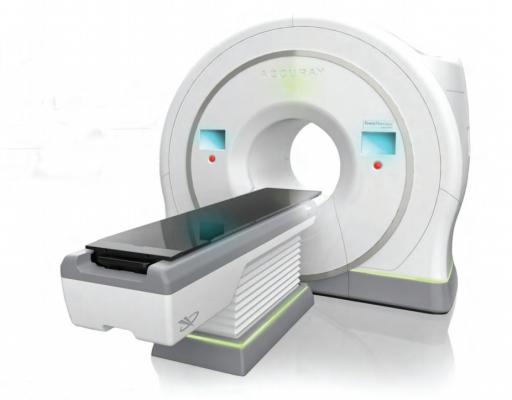
June 12, 2018 — Recently published data from two new studies demonstrate the benefits of Accuray’s TomoTherapy System in the delivery of total body irradiation (TBI). TBI is a procedure commonly used to prepare patients being treated for leukemia and multiple myeloma for a bone marrow transplant. It involves irradiation of the entire body, elevating the need for precision, accuracy and homogeneity in radiation dose delivery. The TomoTherapy platform's architecture enables efficient and effective delivery of radiation over large areas of the patient, making it a valuable part of the bone marrow transplantation conditioning regimen.
In TBI treatments, radiation is administered to the patient as part of a multimodality treatment regimen, typically in combination with high-dose chemotherapy. The irradiation contributes to the eradication of malignant cells, especially those that are chemotherapy-resistant or in sites not easily reached by chemotherapy drugs. TBI also helps prevent the body's immune system from rejecting the healthy donor cells after the transplant.
The TomoTherapy platform, including the next-generation Radixact System, has continuous gantry rotation and couch motion that enables helical delivery of therapy (TomoHelical). This treatment modality produces intensity-modulated radiation from 360 degrees around the patient over very long treatment fields. This significantly enhances the ability to achieve homogeneous dose distributions for TBI, while also simplifying and streamlining the treatment delivery process. TBI treatments on conventional systems have been shown to pose a greater risk of overdosing some areas and underdosing others. Overdosing may lead to toxicity and underdosing means that the goal of eradicating the tumor cells is less likely to be achieved.
Study Highlights
The clinical team from IUCT Oncopole in Toulouse, France shared results of their clinical experience with TomoHelical in a study titled, "Total body irradiation using Helical TomoTherapy: Treatment technique, dosimetric results and initial clinical experience." The study was published in the February 2018 issue of the journal Cancer/Radiothérapie.1 They found:
- The TomoTherapy platform enabled treatment of the entire body in only two segments, the upper body and the lower body. A highly conformal and homogeneous dose distribution was achieved throughout the body, including at the junction between the upper and lower body fields; and
- This approach to conditioning prior to stem cell transplantation facilitated the successful engraftment of all 11 patients included in the study. This was achieved while avoiding radiation pneumonitis, a common side effect following radiation therapy to the chest wall that results in inflammation of the lung. Engraftment is an important milestone in the transplant recovery process.
"An important challenge in successfully providing TBI is attaining consistency of dose in the area of the junction between the treatment segments. In our study, we were able to achieve a 10 percent heterogeneity in the junction area; with a conventional linear accelerator, this would be higher than 20 percent. We want this number to be as low as possible because this means that we're delivering the dose we want to the area receiving radiation," said Dr. Françoise Izar, radiation oncologist, department of radiotherapy, IUCT Oncopole. "Using TomoHelical mode, we were able to provide precise and homogeneous tumor coverage and excellent sparing of organs at risk. We significantly reduced the median dose to selected critical organs and it was possible to escalate dose to the sites at high risk of residual disease, improving long-term outcomes."
Clinicians at Guangzhou General Hospital of Guangzhou Military Command and Sir Run Shaw Hospital in China, published results of their TBI study titled, "Haploidentical hematopoietic SCT using helical tomotherapy for total-body irradiation and targeted dose boost in patients with high-risk/refractory acute lymphoblastic leukemia," in the January 2018 issue of Bone Marrow Transplantation.2 Highlights of the study include:
- In a novel approach, the clinical team used TomoHelical to simultaneously deliver TBI and a targeted radiation dose boost to total marrow, central nervous system and disease sites outside of the bone, to improve outcomes for high-risk or refractory/relapsed patients with leukemia;
- TomoHelical mode provides a rotating beam source with a multileaf collimator moving in a spiral pattern relative to the patient, which allowed large areas to be delineated and treated, while neighboring areas were spared;
- All evaluable patients achieved sustained, full donor stem cell engraftment. One-year overall survival and disease free-survival rates following implantation were both reported as 70.7 percent; and
- No patients experienced recurrent disease after a median follow-up of 14.6 months.
"We took advantage of the TomoTherapy System's ability to deliver different radiation doses to very specific areas of the body at the same time to create an optimal treatment plan, providing one dose to accomplish TBI and simultaneously augmenting this with another dose to the sites that needed additional radiation," said Prof. Li Jing, radiation oncologist and chief at the Helical TomoTherapy Center, Guangzhou General Hospital of Guangzhou Military Command. "We were extremely pleased with the results. Using TomoHelical mode we achieved satisfactory immunosuppression, excellent eradication of malignant tumor cells and individual sparing of organs at high risk of radiation-induced toxicity, enabling us to achieve our clinical objectives."
For more information: www.accuray.com
References


 December 11, 2025
December 11, 2025 









